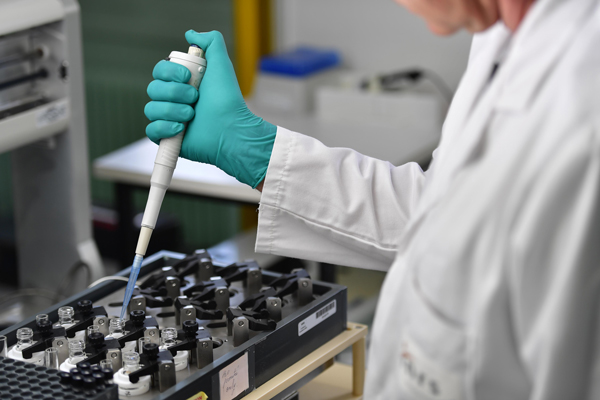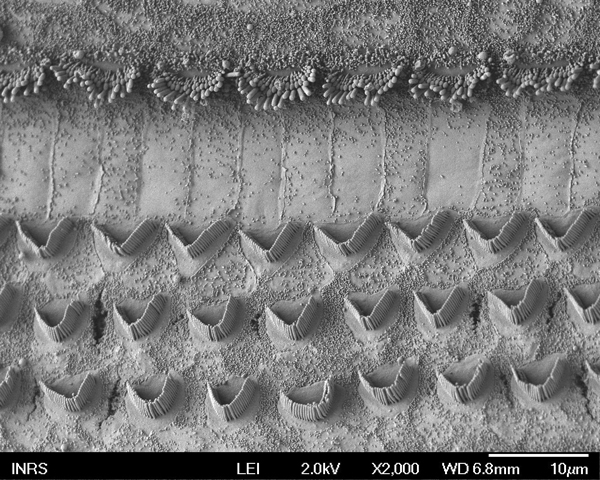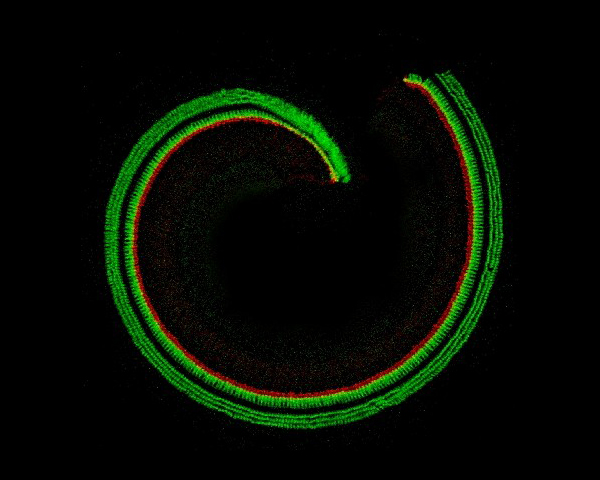Toxicology and biomonitoring division
The Toxicology and Biomonitoring division takes part in many research projects in cancerology, reprotoxicology, immunotoxicology, dermal absorption and in biomonitoring. The researchers of the division work in laboratories with multiple models (in vivo, in vitro, ex vivo, in silico) and in factories to collect biological samples from workers. Its missions are to identify deleterious effects of chemicals, noise or combined exposures, as well as to prevent risks encountered by workers in their environment.
Biomonitoring Laboratory
The laboratory carries out biomonitoring studies of occupational exposures to organic and inorganic chemicals. These activities are part of the prevention of chemical risk in workplaces now integrated into European directives.
Biomonitoring of exposures consists of measuring toxics and / or their metabolites, called biological exposure indicators (BEI), in the biological matrices (urine, blood, exhaled breath condensate, etc.) of exposed employees. The field of application of biomonitoring also includes the monitoring of biomarkers of early reversible effects, such as oxidative stress and indicators of renal damage ...
Therefore, the laboratory develops analytical methods, carries out targeted field work studies to assess occupational exposures, validates the most relevant IBEs, assesses the chemical risk and gives occupational physicians elements to implement a biomonitoring strategy to limit occupational exposures. The data collected in these studies are also used to build biological limit values (VLB) within national and international working groups in which the laboratory participates. Finally, the laboratory performs analyses of hematological and biochemical parameters, in support of the Department's experimental toxicology laboratories.
Publications
- Bousoumah R., Leso V., Iavicoli I., Huuskonen P., Viegas S., Porras S., Santonen T., Frery F., Robert A., Ndaw S. Biomonitoring of occupational exposure to bisphenol A, bisphenol S and bisphenol F: a systematic review. Science of Total Environment. 2021; Volume 783,146905. https://doi.org/10.1016/j.scitotenv.2021.146905
- Martin Remy A., Robert A., Jacoby N., Wild P. Is Urinary Chromium Specific to Hexavalent Chromium Exposure in the Presence of Co-exposure to Other Chromium Compounds? A Biomonitoring Study in the Electroplating Industry. Annals of Work Exposures and Health; 2021 Volume 65, Issue 3, Pages 332–345, https://doi.org/10.1093/annweh/wxaa107
- Ndaw S., Remy A., Jargot D., Antoine G,; Denis F., Robert A. Mycotoxins Exposure of French Grain Elevator Workers: Biomonitoring and Airborne Measurements. Toxins; 2021, 13, 382. https://doi.org/10.3390/toxins13060382 H2020 EU Project : HBM4EU ( https://www.hbm4eu.eu/)
- Erb A., Marsan P., Burgart M., Remy A., Lambert-Xolin A.M., Jeandel F., Hanser O., Robert A. Simultaneous determination of aromatic and chlorinated compounds in urine of exposed workers by dynamic headspace and gas chromatography coupled to mass spectrometry (dHS-GC-MS). J Chromatogr B. 2019; 1125:121724.
Carcinogenesis, Mutagenesis and Reprotoxicity Laboratory
The laboratory is involved in chemical hazard identification. It is using in vitro and in vivo experimental models to investigate reprotoxicity/endocrine disruption as well as genotoxicity and carcinogenic potential of chemicals and nanomaterials.
A wide variety of compounds which are thought to lead to endocrine disruption are found in work places. The laboratory studies the reprotoxic and endocrine disrupting (related to the reproductive function) properties of chemicals and especially their effects on the reproductive system of male offspring following exposure of pregnant female rats. It is also developing in vitro models for the assessment of chemical effects on the steroidogenesis and on the activity of steroid receptors.
The number of workers potentially exposed to nanomaterials is increasing. As nanomaterials may get aerosolized, inhalation represents the main route of occupational exposure. The laboratory investigates the pulmonary toxicity and genotoxicity of nanomaterials in rat model using a dedicated inhalation facility and tries to decipher their underlying toxicological mechanisms of action with the use of high content screening methods (transcriptomics and proteomics). It is also working on the potential in vitro genotoxicity and pre-neoplastic cell transformation properties of nanomaterials and other chemicals with a focus on the cellular and molecular mechanisms involved. More recently, the laboratory has been involved in the development of Adverse Outcome Pathway (AOP) associated with nanomaterial toxicity.
Publications
- Seidel C, Zhernovkov V, Cassidy H, Kholodenko B, Matallanas D, Cosnier F, Gaté L. Inhaled multi-walled carbon nanotubes differently modulate global gene and protein expression in rat lungs. Nanotoxicology. 2021 Mar;15(2):238-256. doi: 10.1080/17435390.2020.1851418.
- Halappanavar S, van den Brule S, Nymark P, Gaté L, Seidel C, Valentino S, , Zhernovkov V, Danielsen PH, De Vizcaya A, Wolff H, Stöger T, Boyadziev A , Poulsen SS, Sørli JB, Vogel U. Adverse outcome pathways as a tool for the design of testing strategies to support the safety assessment of emerging advanced materials at the nanoscale. Part Fibre Toxicol. 2020;17(1):16. DOI: 10.1186/s12989-020-00344-4.
- Kirsch A, Dubois-Pot-Schneider H, Fontana C, Schohn H, Gaté L, Guichard Y. Predictive early gene signature during mouse Bhas 42 cell transformation induced by synthetic amorphous silica nanoparticles. 2020; 5; 315:108900. DOI: 10.1016/j.cbi.2019.108900.
- Saillenfait AM, Ndaw S, Robert A, Sabaté JP. Recent biomonitoring reports on phosphate ester flame retardants: a short review. Arch Toxicol. 2018. 92(9):2749-2778. doi: 10.1007/s00204-018-2275-z
Immunology, Sensitization and Allergy laboratory
The laboratory endeavors to develop in vitro models in order to assess sensitizing potential of low molecular weight chemicals that contribute to both dermal and respiratory sensitizations. The main objectives of the laboratory are to elaborate in vitro tests that can differentiate respiratory allergens from cutaneous ones and assess sensitizing potency of sensitizers. The models being developed use keratinocytes, murine bone marrow derived dendritic cells (BMDC) and cocultures of BMDC and T lymphocytes. In addition to analyzing phenotypic parameters (membrane markers, cytokine production, cell proliferation), our laboratory studies intracellular signaling pathways possibly involved in BMDC or lymphocytes upon exposure to skin or respiratory sensitizers. The studies carried out in the laboratory require numerous techniques, among them: cell cultures, flow cytometry, immunoassays (ELISA, ELISpot), RT-qPCR, Phosphoflow.
The laboratory will also develop a project to identify the airborne allergens from biological origin to which workers of selected food industries are exposed, in order to contribute to the improvement of prevention in this sector.
Publications
- Audry, Adrien; Mathiot, Julianne; Muller, Samuel; Coiscaud, Amélie; Langonné, Isabelle; Battais, Fabrice; Leininger, Brigitte; Sponne, Isabelle. Activation of Nrf2 by a respiratory sensitiser in the dendritic cell highlighted by a new approach combining RT-qPCR and flow cytometry. 2021. Toxicology Research. Submitted.
- Cécile Huppert, Christophe Paris, Isabelle Langonné, Samuel Muller, Julianne Mathiot, Hakima Abdessadeq, François Gagnaire, Fabrice Battais, Isabelle Sponne, Activation of T cells by dendritic cells exposed to a reference sensitizer: Towards a promising model to assess the allergenic potential of chemicals, January 2018, Contact Dermatitis 78(1)
- Fabrice Battais, Cécile Huppert, Isabelle Langonné, Samuel Muller, Isabelle Sponne, In vitro detection of chemical allergens: An optimized assay using mouse bone marrow-derived dendritic cells, May 2017, Contact Dermatitis 77(5)
Ototoxicity and Neurotoxicity laboratory
The activity of the laboratory is focused on the adverse effects of exposures to chemical and physical agents on the central and peripheral nervous systems, with a special emphasis on the inner ear. In the last 20 years, the laboratory has brought a wealth of information on the ototoxic mechanisms of industrial compounds (mostly solvents) using in vivo measurements and state-of-the-art histological analyses. More recently, studies focused on the development of non-invasive functional tests in order to identify early biomarkers of auditory and balance impairments caused by solvent exposure, with or without noise. The laboratory also conducts on-site studies with workers exposed to noise and/or chemical agents to corroborate experimental laboratory research.
Publications
- Tallandier V, Chalansonnet M, Merlen L, Boucard S, Thomas A, Campo P, Pouyatos B. An in vitro model to assess the peripheral vestibulotoxicity of aromatic solvents. Neurotoxicology. 2021 May;84:105-113. doi: 10.1016/j.neuro.2021.03.002. Epub 2021 Mar 17. PMID: 33722544.
- Wathier L, Venet T, Bonfanti E, Nunge H, Cosnier F, Parietti-Winkler C, Campo P, Pouyatos B. Measuring the middle-ear reflex: A quantitative method to assess effects of industrial solvents on central auditory pathways. Neurotoxicology. 2019 Sep;74:58-66. doi: 10.1016/j.neuro.2019.05.007. Epub 2019 May 20. PMID: 31121240.
- Chalansonnet M, Carreres-Pons M, Venet T, Thomas A, Merlen L, Boucard S, Cosnier F, Nunge H, Bonfanti E, Llorens J, Campo P, Pouyatos B. Effects of co-exposure to CS2 and noise on hearing and balance in rats: continuous versus intermittent CS2 exposures. J Occup Med Toxicol. 2020 May 11;15:9. doi: 10.1186/s12995-020-00260-5. PMID: 32426022; PMCID: PMC7216478
- Venet T, Bey A, Campo P, Ducourneau J, Mifsud Q, Hoffmann C, Thomas A, Mouzé-Amady M, Parietti-Winkler C. Auditory fatigue among call dispatchers working with headsets. Int J Occup Med Environ Health. 2018 Jan 1;31(2):217-226. doi: 10.13075/ijomeh.1896.01131. Epub 2017 Oct 25. PMID: 29072709.
Toxicokinetics, Inhalation and Percutaneous absorption laboratory
The laboratory studies the toxicokinetics - absorption, distribution, metabolism and excretion - of industrial chemicals following mainly dermal and inhalation exposures (the two major routes of occupational exposure).
The percutaneous absorption/penetration of substances is evaluated in vivo in animals or in vitro using static Franz diffusion cells with human or animal excised skin. For these purposes, in addition to the development of analytical methods for the measurement of substances of interest in biological media, the laboratory has the required qualifications and equipment for the use and analysis of radiolabeled substances.
The laboratory is also specialized in the generation of atmospheres (gaseous, vapors or aerosols) and their characterization for the purposes of toxicology studies by inhalation in rodents. It is therefore one of the rare laboratories to have facilities dedicated to the study of the effects of mixed exposures - mixtures of chemical(s) and / or physical agent (s) – but also of nanoparticles aerosols.
Since recently, physiologically based pharmacokinetic (PBPK) and quantitative structure activity relationship (QSAR) modelling has become an important objective. It should help to anticipate the effects of substances (some proposed as a substitute) and eventually to prioritize the substances for which additional studies are necessary.

© INRS
Publications
- Champmartin C, Marquet F, Chedik L, Décret M-J, Aubertin M, Ferrari E, Grandclaude M-C, Cosnier F. Human in vitro percutaneous absorption of bisphenol S and bisphenol A: A comparative study. Chemosphere. 2020;252:126525; doi: 10.1016/j.chemosphere.2020.126525.
- Devoy J, Nunge H, Bonfanti E, Seidel C, Gaté L, Cosnier F. Quantitative measurement of carbon nanotubes in rat lung. Nanotoxicology. 2020;14 9:1227-40; doi: 10.1080/17435390.2020.1814439.
- Hopf NB, Champmartin C, Schenk L, Berthet A, Chedik L, Du Plessis JL, Franken A, Frasch F. Gaskin S, Johanson G, Julander A, Kasting G, Kilo S, Larese Filon F, Marquet F, Midander K, Reale E, Bunge, A. L. Reflections on the OECD guidelines for in vitro skin absorption studies. Regul Toxicol Pharmacol 2020;117:104752; doi: 10.1016/j.yrtph.2020.104752.
- Cosnier F, Seidel C, Valentino S, Schmid O, Bau S, Vogel U, Devoy J, Gaté L. Retained particle surface area dose drives inflammation in rat lungs following acute, subacute, and subchronic inhalation of nanomaterials. Part Fibre Toxicol. 2021; doi: 10.1186/s12989-021-00419-w.




